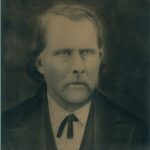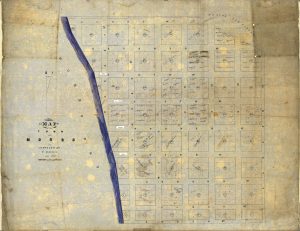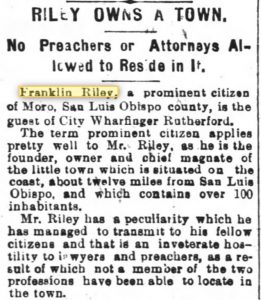Franklin Riley
The Man Who Owned a Town

Franklin Riley Source: Historical Society of Morro Bay
About Franklin Riley, in His “Own” Words
You can learn more about the basics of Franklin Riley’s life in the interpretive panel shown at the bottom of this page. Here we have a fun way to tell that story. Morro Bay resident Ed Bischof dressed up as Franklin for one of the Historical Society’s in-person member meetings and we did an interactive interview with him to tell the story. The text below is based on that performance.
Good afternoon!
There was a time when everyone in Morro Bay Township knew me. I’m Franklin Riley, the fellow who with some help from my friends and associates established the original township. We turned the dirt around here into a regular town, mostly during the 1870’s and 1880’s.
I am really glad to see you’ve kept the central part of the town almost like it was when Carolan Mathers and I laid it out. He was a surveyor and a partner of mine. Those blocks near the intersection of Main Street and 5th Street —the one you now call “Morro Bay Boulevard's go together just the same as they did in 1872 when we laid out the track and cleared the scrub for streets. Of course it looks a bit different today with all the fancy buildings.

Morro Bay Plat Map Source: Historical Society of Morro Bay
It was a long hard journey — I don’t know if I’d do it again knowing what I know now — but we finally made it to California.
What we had accomplished is another thing. California is a huge state, and though parts like the Central Valley appeared good for farming, we had caught a fever to push on to the edge of the country, along the ocean. I was always looking for ways to develop opportunities so working as a farm hand and miner during those first years, I worked to build a stake for something better and more permanent.
It was really a struggle in those early days what with that northwest wind — you know the one I mean — tearing across our coastal dunes and shrubs, throwing sand into the air along with about anything you might have been optimistic enough to plant. That wind is what led me to get those Blue Gum Eucalyptus seeds and plant along 5th Street and along the bluff – we were just trying to get some wind shelter. I was ready to give up more than once, but for the support and encouragement of Hannah my wife and my friend JC Stocking. He owned land just south of the township property and was a blacksmith with whom I sometimes partnered.

JC Stocking Farm Source: Historical Society of Morro Bay
You see, I was a farmer by trade. I was born in 1824 in a Midwestern farm town in Indiana and that’s what we all did: farm. Back there the soil is deeper and darker, a rich dirt that yields a good life if you were willing to make the effort.
Once I was grown, in my early 20s, I knew I had to strike out on my own so the family farm could continue to support my birth family. I needed land if I wanted a farm and family of my own. So I set out for Iowa, one of the flattest places you’ll ever see, And that flat land was flat out fertile. I found a parcel near Lodomillo, in Clayton County Iowa that I could afford and started to build a future. Lodomillo was and still is a very rural place about 50 miles north east of Cedar Rapids and not far from the Mississippi River.
However, the best thing that happened to me in Lodomillo was meeting Hannah Merrill who was from New Hampshire. We married on June 21st in 1848 and just about a year later Hannah gave me twin girls, Phebe and Sara.
Things were going OK in Iowa, considering how primitive it still was, but during that first year of Phebe and Sara’s lives it seemed half the country was moving west to California to get rich quick. Then Sara died of the fever and it broke our hearts. The loss of Sara and the itch to follow the crowd west got to us so Hannah and I hitched up the wagon with as much stuff as we could carry and started walking west.
Phebe, Hannah and I finally ended up in San Luis Obispo County near Cambria at the end of the 1850’s. I want you to know the place was just as drop dead beautiful as it is now, just a lot rougher. Most of the useful land was held in the big old Mexican Ranchos where they raised cattle. The dairymen were beginning to move in — it was mostly about cows, with a few smaller farming operations setting down roots.
Phebe’s soul left us in those early years in SLO County. Now it was just Hannah and me searching for a way to make a living. As is the way of fate, we were blessed during this time with Jesse, Lizzie and Mary, who we adopted as young teens when they needed a home and we needed a family.
One day I noticed that there was a piece of land near the old Morro Rock that didn’t seem to be used for anything. I found out that it abutted the Rancho San Bernardo, but it was available for homesteading! I jumped at the chance! Even though the land was not prime for farming, I figured we ought to be able to get something out of it, and anyhow, the place looked perfect for landing ocean-going boats for trading goods.
Thank God for the homestead act after the Civil War: it made it possible for me to acquire the land.
In January 1872, my title was perfected. All I had to do was figure out how to wring some dollars from the place. I knew Carolan Mathers through farm talk with his Dad James, and Carolan was a surveyor. So we decided to lay out a town grid in perfect square blocks and begin to make the streets and improvements that would entice other settlers. Lots of people were still coming to California and they couldn’t all fit in that crowded San Francisco.

Source: San Francisco Call article
I got my friend JC Stocking, who was a blacksmith, to move here with his family and he was one of the first to buy land to settle down. The Rev AB Spooner was another. Spooner had settled along Toro Creek a few years earlier and farmed until we had the town scratched into the sand and he bought several parcels. He was living in the town on the fateful day in February 1877 when he died trying to pilot the steamship “Mary Taylor” into that difficult harbor in the Morro Bay estuary. Alden was the same age as me when he died.
Hannah and I lived the rest of our lives in Morro Bay. I tried my hand at commerce with a small wharf — it made some money for us, but never could compete with the deeper water pier that James Cass built at Cayucos. I was an active member of the community: I joined the Grange for a while and served as Justice of the Peace in Morro Bay.
All in all, we lived a good life and had a lot of fun along with the never-ending work. I am grateful we found Morro Bay.

The Hidden History panel about Franklin Riley will be installed in Franklin Riley Park near the intersection of Morro and Olive (on the bluff top above Tidelands Park—there is a stair between the Franklin Riley Park and the Embarcadero). When the park installation is complete, there will be other panels describing the history of Morro Bay over much longer time periods than the one since Franklin walked the streets.
© Copyright HSMB 2025
